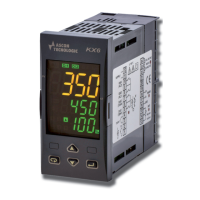Ascon Tecnologic - KX6 - ENGINEERING MANUAL - PAG. 6
6 CONFIGURATION PROCEDURE
6.1 Introduction
When the instrument is powered, it starts immediately to work
according to the parameters values loaded in its memory.
The instrument behaviour and its performance are governed
by the value of the stored parameters.
At the first start up the instrument will use a “default”
parameter set (factory parameter set); this set is a generic
one (e.g. a TC J input is programmed).
m
Before connecting the output actuators,
we recommend to configure the parameters to suit
your application (e.g.: input type, Control strategy,
alarms, etc.).
m
Do not change the [5] Unit (Engineering Unit) value
during process control as the set point inserted by
the user (thresholds, limits etc.) are not automatically
rescaled by the instrument.
To change these parameters you need to enter the
“Configuration mode”.
6.2 Instrument behaviour at Power ON
At power ON the instrument can start in one of the following
mode depending on its configuration:
Auto mode.
– The upper display will show the measured value;
– The meddle display will show the Set point value;
– The lower display will show the valve position (measured
or theoretical according to the control strategy selected).
– The instrument is performing the standard PID control with
servo-motor drive output.
Manual mode (oPLo).
– The upper display shows the measured value;
– The middle display shows the power output [preceded by H
(for heating) or C (for cooling)]. The MAN LED is lit;
– The lower display will show the valve position (measured
or theoretical according to the
selected control
).
– The instrument does not perform Automatic control;
– The control output can be manually modified by and
buttons.
Stand by mode (St.bY).
– The upper display will show the measured value;
– The middle display will show alternately the set point value
and the message St.bY or od;
– The lower display will show the valve position (measured
or theoretical according to the control strategy selected).
– The instrument does not perform any control (the Out 2
[close] is ever ON);
– The instrument is working as an indicator.
6.3 Configuration modes
6.3.1 How to enter the “Configuration modes”
The configuration mode allows to take advantage of all
instrument features.
The instrument have one complete parameter set.
We call this set “configuration parameter set” (or
“configuration parameters”).
The access to the configuration parameters is
protected by a
password.
Note: The instrument will show only the parameters consistent
with the specific hardware and in accordance with the
value assigned to the previous parameters
(e.g.: if you set an Alarm as “not used” the instrument
will mask all other parameters related to this Alarm).
6.3.2 Complete configuration procedure
The configuration parameters are collected in various
groups. Every group defines all parameters related with a
specific function (e.g.: control, alarms, output functions).
1. Push the button for more than 5 seconds. The upper
display will show PASS while the middle display will show 0.
2. Using
and
buttons set the programmed password.
Notes: 1. The factory default password for configuration
parameters is equal to 30.
2. During parameter modification the instrument
continue to perform the control.
In certain conditions, when a configuration change
can produce a heavy bump to the process, it is
advisable to temporarily stop the controller from
controlling during the programming procedure
(control output will be OFF).
A password equal to 2000 + the programmed
value (e.g. 2000 + 30 = 2030).
The control will restart automatically when the
configuration procedure will be manually closed.
3. Push the button.
If the password is correct the display will show the
acronym of the first parameter group preceded by
the symbol:
]
.
In other words the upper display shows:
]inp
(group of the Input parameters).
The instrument is in configuration mode.
6.3.3 How to exit the “Configuration mode”
Push button for more than 5 seconds, the instrument will
come back to the “standard display”.
6.4 Keyboard functions during
parameter changing
A short press allows to exit from the current parameter
group and select a new parameter group.
A long press allows you to close the configuration
parameter procedure (the instrument will come back
to the “standard display”).
When the upper display is showing a group and the
middle display is blank, this key allows to enter in the
selected group.
When the upper display is showing a parameter and
the middle display is showing its value, this key allows
to store the selected value for the current parameter
and access the next parameter within the same group.
Allows to increase the value of the selected parameter.
Allows to decrease the value of the selected parameter.
+ These two keys allow to return to the previous
group. Proceed as follows:
Push the button and maintaining the pressure,
then push the button; release both the buttons.
Note: The group selection is cyclic as well as the selection
of the parameters in a group.

